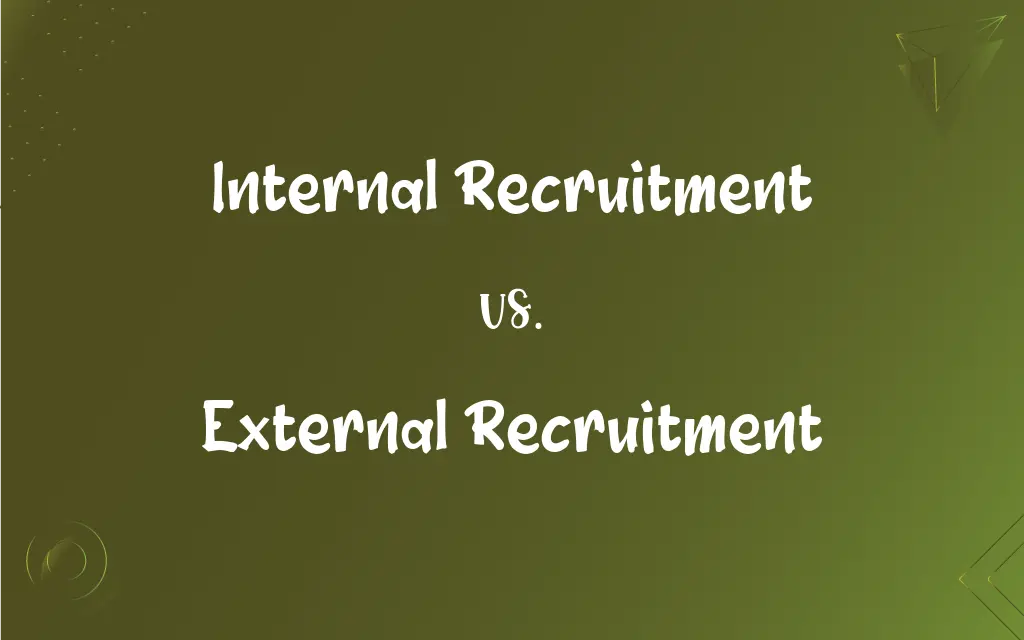Internal Recruitment vs. External Recruitment: What's the Difference?
Edited by Janet White || By Harlon Moss || Updated on October 23, 2023
Internal recruitment involves filling job roles from within an organization, while external recruitment seeks candidates from outside the organization.

Key Differences
Internal recruitment refers to the process of hiring employees from within the current workforce of an organization. External recruitment, on the other hand, is the practice of seeking candidates from the broader job market, outside the confines of the organization.
When considering sources, internal recruitment typically involves promotions, transfers, or referrals from existing employees. External recruitment, conversely, leverages job boards, recruitment agencies, and other external sources to find suitable candidates.
In terms of advantages, internal recruitment often results in quicker and less expensive hires, as the candidates are already familiar with the company culture and processes. External recruitment brings fresh perspectives and skills, introducing diversity and innovation into the organization.
Regarding the scope, internal recruitment usually has a narrower candidate pool, focusing on existing employees. External recruitment, however, offers a broader range of applicants, potentially yielding a wider variety of skills and experiences.
In terms of time and resources, internal recruitment might require less training and orientation since candidates already understand the organization's operations. In contrast, external recruitment may need a more comprehensive onboarding process to integrate new hires into the company.
ADVERTISEMENT
Comparison Chart
Source
From within the organization.
From the broader job market outside the organization.
Advantages
Familiarity with company culture; quicker hires.
Fresh perspectives; potential for greater skills diversity.
Scope of Candidates
Narrower, existing employees.
Broader, includes anyone in the job market.
Cost & Time
Typically less expensive and faster.
Might involve more costs and time due to advertising and extensive onboarding processes.
Orientation Needs
Less intensive, as candidates are familiar with company processes.
More comprehensive onboarding may be required.
ADVERTISEMENT
Internal Recruitment and External Recruitment Definitions
Internal Recruitment
Hiring process focusing on existing employees.
The company prefers internal recruitment for managerial positions to maintain continuity.
External Recruitment
The practice of filling positions with candidates not currently affiliated with the company.
The startup used external recruitment to build its team from scratch.
Internal Recruitment
Elevating employees to higher roles based on their performance.
The firm believes in growth from within, hence the emphasis on internal recruitment.
External Recruitment
Attracting talent from outside the current employee base.
External recruitment efforts included a nationwide job ad campaign.
Internal Recruitment
Filling job vacancies with current organizational members.
Internal recruitment was initiated to find a replacement for the retiring CFO.
External Recruitment
Hiring strategy involving the larger job-seeking community.
To ensure diversity, the company emphasized external recruitment for its executive roles.
Internal Recruitment
The practice of promoting or transferring current employees to new roles.
Through internal recruitment, Lisa moved from sales to the marketing department.
External Recruitment
Hiring process that sources candidates outside the organization.
External recruitment was chosen to bring in fresh perspectives to the design team.
Internal Recruitment
Selecting candidates from the existing workforce.
Internal recruitment efforts resulted in three current employees vying for the team lead role.
External Recruitment
Seeking potential employees from the broader job market.
External recruitment agencies were employed to find specialized software developers.
FAQs
How does external recruitment differ?
External recruitment seeks candidates from outside the organization, from the broader job market.
Can a company use both internal and external recruitment simultaneously?
Yes, many companies use a mix of both, depending on the specific hiring needs and roles.
What is internal recruitment?
Internal recruitment is hiring employees from within the current workforce of an organization.
Which is typically faster, internal or external recruitment?
Internal recruitment is often quicker since candidates are already familiar with the company.
Is external recruitment more expensive?
Typically, external recruitment can be more costly due to advertising and agency fees.
Why might a company favor internal recruitment?
It promotes loyalty, utilizes existing talent, and often requires less training.
What are the benefits of external recruitment?
It brings in fresh perspectives, skills, and can lead to increased diversity.
Do employees favor internal recruitment?
Many do, as it provides opportunities for growth and advancement within the company.
Which method is more predictable in terms of candidate performance?
Internal recruitment can be more predictable since the employee's performance is already known.
Is internal recruitment only about promotions?
Not always. It can involve lateral moves, transfers, or filling vacant roles without promotions.
What sources are used in external recruitment?
Job boards, recruitment agencies, job fairs, and university recruiting are common sources.
Which method is better for high-level executive roles?
Both can be used, but external recruitment often provides a broader range of experienced candidates.
Is employee referral internal or external recruitment?
It's a blend; while referrals come from internal employees, the candidates themselves are external.
Can external recruitment enhance company culture?
Yes, by bringing diverse experiences and backgrounds, it can enrich and evolve company culture.
Can internal recruitment be biased?
If not properly managed, it may favor certain employees, leading to perceptions of favoritism.
How can external recruitment improve a company?
It can introduce new skills, experiences, and innovative approaches not present in the current workforce.
Can external recruitment lead to competitiveness?
Yes, it can spur internal employees to enhance their skills knowing positions aren't guaranteed to them.
What role do HR departments play in both methods?
HR typically manages or oversees both processes, ensuring they align with company policies and goals.
How does training differ between the two methods?
Internal recruits might need less training, while external recruits may require comprehensive onboarding.
Are there risks with external recruitment?
Potential risks include culture misfit, longer adjustment periods, and higher initial training costs.
About Author
Written by
Harlon MossHarlon is a seasoned quality moderator and accomplished content writer for Difference Wiki. An alumnus of the prestigious University of California, he earned his degree in Computer Science. Leveraging his academic background, Harlon brings a meticulous and informed perspective to his work, ensuring content accuracy and excellence.
Edited by
Janet WhiteJanet White has been an esteemed writer and blogger for Difference Wiki. Holding a Master's degree in Science and Medical Journalism from the prestigious Boston University, she has consistently demonstrated her expertise and passion for her field. When she's not immersed in her work, Janet relishes her time exercising, delving into a good book, and cherishing moments with friends and family.
































































